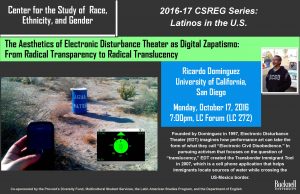Founded by Dominguez in 1997, the Electronic Disturbance Theater (EDT) company imagines how performance art can take the form of what they call “Electronic Civil Disobedience.” During the first phase of nonviolent protest during the 1990s, called EDT 1.0, the collective focused on how cyberactivism could counter the opaque anonymity that was running rampant online. By enacting a “radical transparency” that connected real material bodies to online data bodies, EDT’s performance art echoed the Gandhian method that linked the soul and body as key to civil disobedience. After 9/11, EDT 2.0 shifted away from “transparency,” which they viewed now a neoliberal protocol of containment and control, towards “translucency” as their wild-aesthetic-in-the-wild. In pursuing activism that focuses on the question of “translucency,” EDT created the Transborder Immigrant Tool in 2007, which is a cell phone application that helps immigrants locate sources of water while crossing the US-Mexico border.
